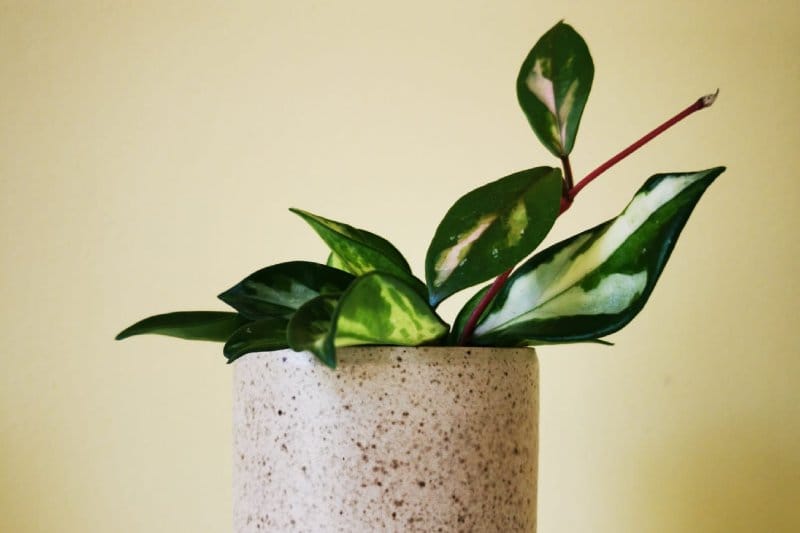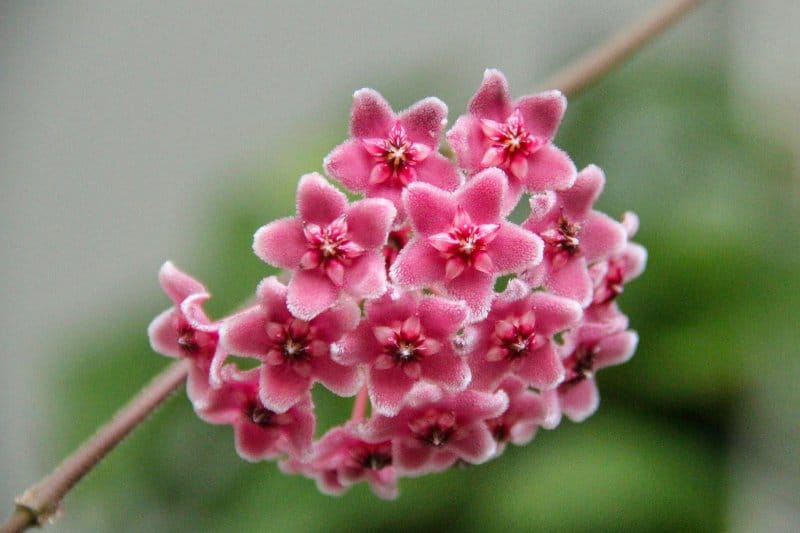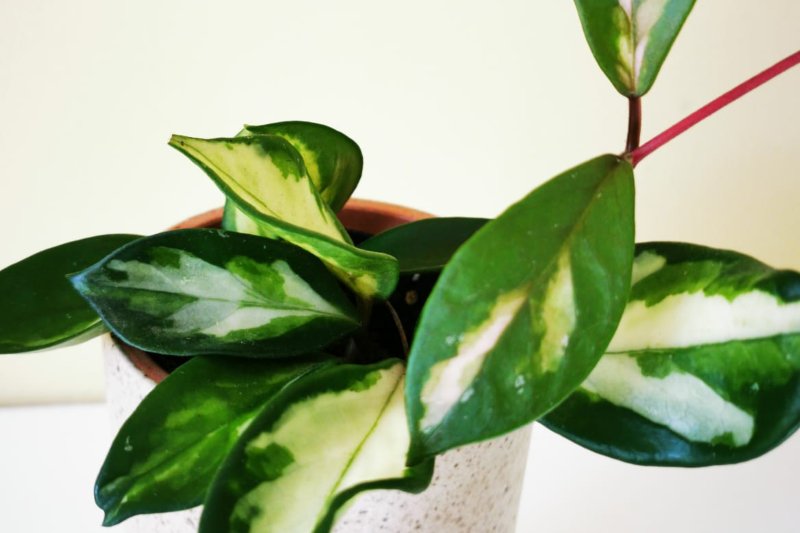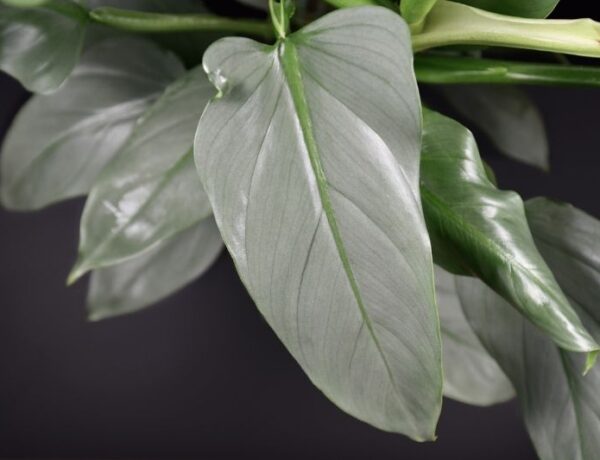Hoya Tricolor (Hoya carnosa 'Krimson Princess') Plant Care Snapshot
Hoya Tricolor thrives on bright, indirect light, sparse sips of water, and the occasional “oops, I forgot” moment.
Watering
Every 2-3 weeks
Light
Bright, indirect light or dappled sun.
Growth Rate
Slow to moderate
Care Level
Beginner-friendly – as long as you're not overwatering
Not Pet Friendly
Toxic if chewed
Creamy-Pink Centers & Trailing Green Edges
Your Hoya Tricolor flaunts thick, waxy, oval leaves with creamy centers and deep-green margins—flash them in bright light and you’ll get blush-pink highlights like shy sunsets.
Over time, its vines shoot out long tendrils that loop and drape off shelves or sway from hanging pots like living streamers, bringing a sculptural, cascading accent to your space.
Give it enough light, and mature plants might surprise you with clusters of pale-pink, star-shaped parasol blooms, lightly scented—though let’s be honest, those variegated leaves are the real headliners.

Hoya Tricolor Plant Care & Growing Requirements
Ready to keep those creamy vines thriving? Here’s what your Hoya Tricolor (Hoya carnosa ‘Krimson Princess’) needs:
Watering Schedule
Hoya Tricolor lives by the soak-and-dry rule—water thoroughly when the top 1–2″ of soil feels dry (about every 2–3 weeks in spring/summer, and about once a month in cooler months).
Quick Tips:
- Water until you see runoff, then dump any excess.
- Finger-test 1–2″ down—if it’s dry, go for it.
- Use tepid, low-mineral water (rain, filtered, or distilled).
- Never let the pot sit in a water-filled saucer.
Light & Placement
Bright, indirect light (or a splash of morning sun) keeps those creamy-pink centers bold. Too little light = more green; too much midday blaze = scorched edges.
Quick Tips:
- Aim for 4–6 hours of bright, filtered light daily.
- Soften harsh rays with a sheer curtain.
- Rotate the pot each week for even variegation.
- In winter, slide closer to the window—but pull back if leaves fry.
Soil & Potting
A chunky, well-draining mix is non-negotiable. Think orchid bark plus perlite and a dash of peat or coco coir. Repot only when root-bound (every 2–3 years) in spring.
Quick Tips:
- Use a potting blend that feels loose and airy.
- Always choose a pot with a drainage hole.
- Upgrade to a pot just one size larger.
- Gently tease circling roots and trim any mushy bits.
- Top-dress with fresh mix instead of over-potting.
Humidity & Temperature
Ideal temps: 65–85°F (18–29°C). Keep it above 50°F (10°C) and away from cold drafts or hot vents. Average home humidity is fine, but 40%+ RH helps leaves stay plump.
Quick Tips:
- Group plants or use a pebble tray if your air dips below 40% RH.
- Avoid heaters, A/C blasts, and drafty windows.
- Brown leaf tips often mean dry air or sudden chills.
- A light mist around (not on) the foliage can boost comfort.
Propagation
Stem-cutting magic: snip a 4–6″ stem just below a node, then let the cut end callous for 24–48 hours before rooting.
Quick Tips:
- Trim just below a node for best rooting.
- Change water every few days if using a vase.
- Keep cuttings in bright, indirect light.
- Expect roots in 2–4 weeks—then pot up and show off!
Fertilizer
Optional but rewarding—use a 3-1-2 (or similar balanced) fertilizer at ¼–½ strength once a month in spring/summer. Skip feedings in fall/winter.
Quick Tips:
- Water first, then fertilize to avoid burn.
- Flush the pot with plain water every few months to clear salts.
- Too much N = lots of green, loss of those beautiful pink tones.
Flower Care
With maturity and bright light, your Hoya may produce clusters of fragrant, star-shaped, pale-pink blooms on pendant umbels.
Quick Tips:
- Encourage blooms with bright days and slightly cooler nights.
- Leave spent flower spokes for a whimsical look—or snip them off to redirect energy to foliage.
- Plan on patience: most indoor Hoyas bloom only after 2–3 years of happy growth.
Essentials & Stylish Accents
Equip your Hoya Tricolor with the core tools it needs—loose-draining soil, a fun planter, targeted light, and a bespoke feed—to keep those variegated vines thriving.

Chunky Potting Mix for Indoor Plants
Ready-to-use coarse mix of orchid bark, perlite & charcoal that skips the peat and keeps your tricolor perched happily.
Shop on Amazon →
Plant Trellises for Climbing Houseplants
Black wrought-iron frames in charming heart shapes—give your Krimson Princess vines something stylish to climb, indoors or out.
Shop on Amazon →
Full-Spectrum Led Grow Light
Height-adjustable, timer-equipped lamp with full-spectrum LEDs and four dimmer levels—keeps your tricolor’s variegation crisp even in low-light corners.
Shop on Amazon →
Liquid Hoya Fertilizer
Organic, pet-safe 3-1-2 formula crafted for Hoya’s needs—promotes lush foliage and abundant blooms. Mix 1 tsp per gallon and feed monthly in spring/summer.
Shop on Amazon →As an Amazon Associate, I earn from qualifying purchases—thanks for supporting our plant guides!
Foliage & Close-Up Gallery



Hoya carnosa 'Krimson Princess' Got Questions? We've got answers!
Is Hoya Krimson Princess easy to care for?
Absolutely—this variegated vine is surprisingly low-maintenance.
Give it bright, indirect light, a well-draining potting mix, and water only when the top 1–2 inches of soil dry out. Forget-me-not moments are totally fine.
Does Hoya Krimson Princess like to climb?
Yes! In its native habitat it clings to tree trunks, so indoors it will happily scramble up a trellis, moss pole, or even a nail in the wall.
No support? Let it trail from a hanging basket for a soft, cascading look.
Can Hoya Krimson Princess revert?
It can—if light levels drop too low, those creamy-pink centers may shrink or vanish, and solid green shoots can appear.
If that happens, pinch away the all-green growth and move your plant to a brighter spot to encourage the cool variegation to return.
Is Krimson Princess Hoya toxic to dogs?
Hoya carnosa contains calcium-oxalate crystals—ingestion can irritate mouths and upset tummies in cats and dogs.
Do Hoyas like deep or shallow pots?
Shallow and snug! Hoyas are epiphytic, so they prefer a little “root crowding.”
Choose a pot that’s only an inch or two wider than the root ball, with plenty of drainage holes. A too-deep pot risks soggy roots.
How many years until my Hoya Princess blooms?
Patience pays off—most ‘Krimson Princess’ vines flower in about 2–3 years once they’ve built up a sturdy, mature stem.
Bright light, a dash of fertilizer in spring/summer, and warm nights help coax out those star-shaped umbels.
Do Hoyas like to be misted?
They appreciate humidity, but direct misting can sit on those waxy leaves and lead to rot. Instead, aim for a humidity tray or group plants together to raise ambient moisture.
If you mist, do it lightly and early in the day so any droplets evaporate before night.
What’s the difference between ‘Krimson Princess’ and ‘Krimson Queen’?
Think of them as mirror-image sisters. ‘Princess’ sports creamy-pink centers fringed by deep green, while ‘Queen’ flips the script with rich green centers edged in white or pale pink.
Both share the trademark red vines and waxy leaves—just a different color story.
Conclusion
With a little light love, occasional watering, and that signature “forget-me-not” attitude, your Hoya ‘Krimson Princess’ will reward you with glossy variegation and, with patience, charming star-shaped blooms.
Remember: bright, indirect sun + a well-draining mix + gentle neglect = happy vines. Craving more easy-care green goodies? Don’t miss our Low-Maintenance Houseplants roundup—perfect for busy plant parents who still want a touch of jungle chic.






No Comments